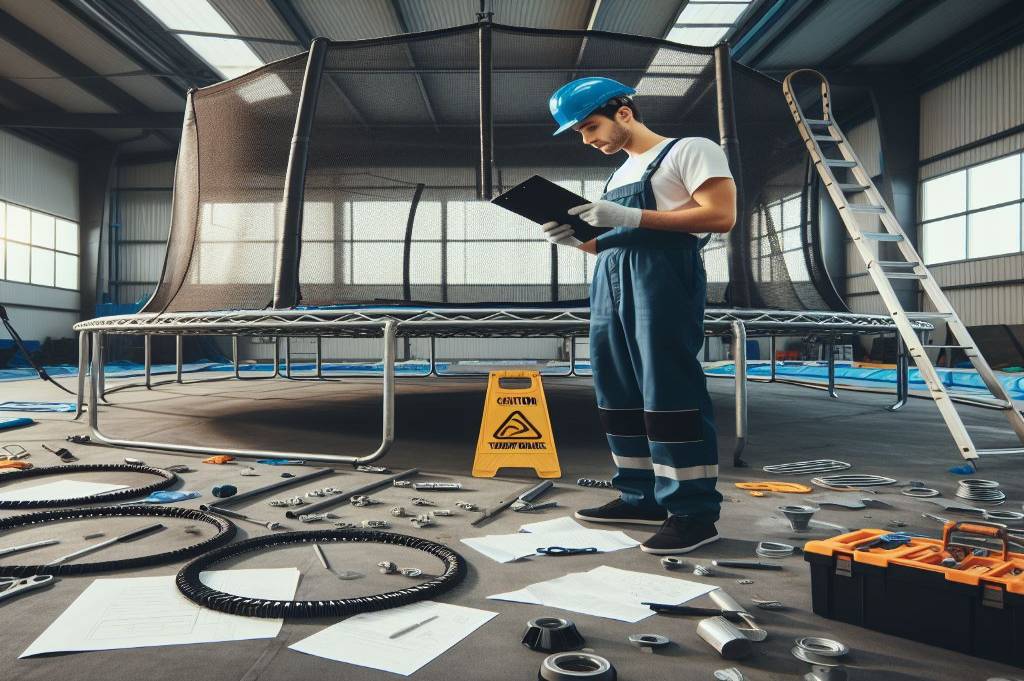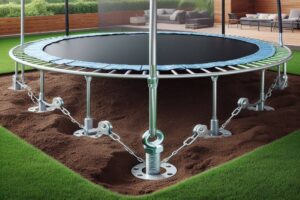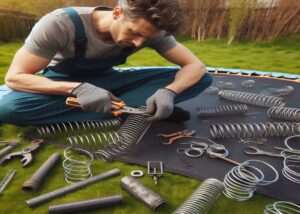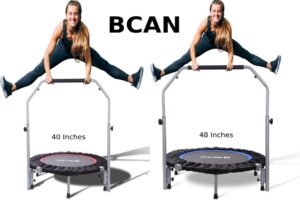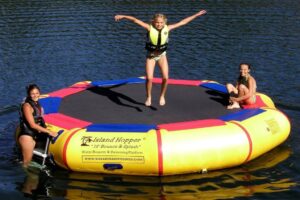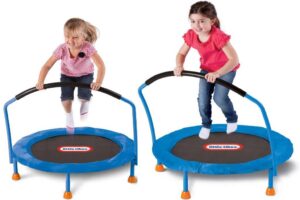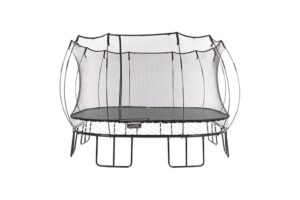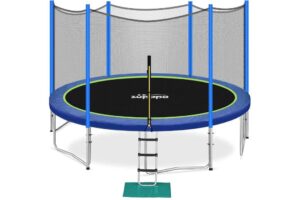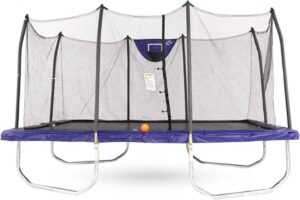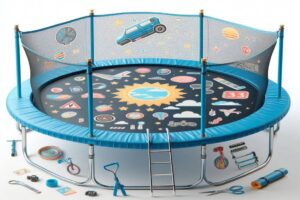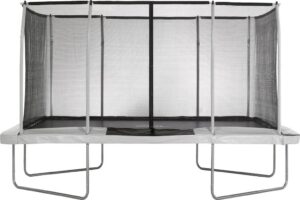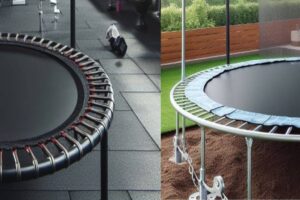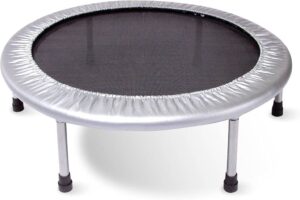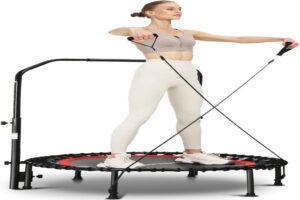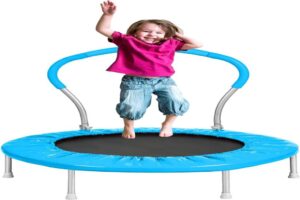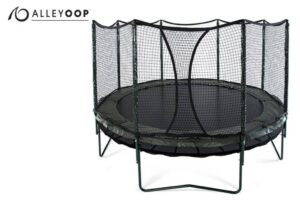Introduction
Trampoline maintenance isn’t just a routine task; it’s the cornerstone of your bouncing haven. Whether you’re a seasoned trampoline enthusiast or stepping into the world of bouncing for the first time, understanding the significance of trampoline maintenance is paramount for ensuring a safe, enjoyable, and long-lasting bouncing experience.
Why does trampoline maintenance matter so much? Your trampoline is more than just a piece of equipment; it’s your portal to moments of boundless joy, exhilaration, and fitness. However, just like any prized possession, it requires care and attention to preserve its performance and safety standards.
Regular trampoline maintenance serves as the backbone of your bouncing adventures. It’s the proactive approach to ensuring that every jump, flip, and twist is executed with confidence and security. By diligently tending to your trampoline, you not only extend its lifespan but also enhance its functionality and safety features.
From inspecting the frame for signs of wear and tear to weatherproofing the surface against the elements, each maintenance task contributes to the overall health and performance of your trampoline. It’s about creating a bounce spot where every bounce is met with assurance and excitement, whether you’re aiming to reach new heights or simply enjoying a leisurely bounce session.
Here, we’ll embark on a journey into the realm of trampoline maintenance, uncovering a wealth of tips, tricks, and best practices to keep your bounce spot in peak condition. Together, we’ll explore everything from conducting thorough inspections to implementing preventative measures, ensuring that your trampoline remains a safe and inviting space for endless bouncing adventures.
So, get ready to dive deep into the world of trampoline maintenance. Let’s equip ourselves with the knowledge and tools needed to preserve and enhance our bouncing haven, allowing us to embark on countless moments of joy, laughter, and fitness with peace of mind and confidence.
Inspecting Your Trampoline
When it comes to trampoline maintenance, safety should always be your top priority. Regular inspections of your trampoline’s key components are essential for ensuring a safe and enjoyable bouncing experience for everyone. Here, we’ll dive into the critical aspects of trampoline safety, focusing on checking the frame and springs, examining the jumping mat, and inspecting the safety enclosure net.
Checking Frame and Springs
The frame and springs form the foundation of your trampoline’s structure, providing support and stability during every bounce. Start by visually inspecting the frame for any signs of rust, corrosion, or damage. Pay close attention to welds and joints, as these are common areas where wear and tear may occur over time. If you notice any cracks, bends, or other abnormalities, it’s essential to address them promptly to prevent further deterioration.
Next, examine the springs carefully. Check for rust, stretching, or broken coils, as these can compromise the trampoline’s integrity and pose a safety hazard. Ensure that all springs are securely attached to the frame and evenly spaced to maintain consistent tension across the jumping surface. If you encounter any damaged or missing springs, replace them immediately with high-quality replacements to maintain optimal bounce performance and safety.
Examining Jumping Mat
The jumping mat is the centerpiece of your trampoline, bearing the brunt of every bounce and jump. Begin by inspecting the surface for any tears, holes, or fraying along the edges. These can weaken the integrity of the mat and increase the risk of injury if left unaddressed. Additionally, check for signs of UV damage, such as fading or brittleness, which can occur over time due to prolonged exposure to sunlight.
Test the elasticity of the jumping mat by applying gentle pressure with your hand. It should feel firm and springy, indicating that it’s in good condition. If you notice any sagging or stretching, it may be a sign of wear and tear, requiring either tightening or replacement. Regularly cleaning the jumping mat with mild soap and water can help prolong its lifespan and maintain optimal performance.
Inspecting Safety Enclosure Net
The safety enclosure net is your trampoline’s first line of defense against falls and accidents. Carefully examine the netting for any tears, holes, or loose stitching that may compromise its effectiveness. Ensure that the net is securely attached to the frame and that there are no gaps or openings where users could slip through.
Check the integrity of the zipper or entrance mechanism, ensuring that it functions smoothly and securely locks in place when closed. Any signs of damage or malfunction should be addressed immediately to prevent unauthorized access to the trampoline and mitigate the risk of injuries.
In conclusion, conducting regular safety inspections of your trampoline’s frame, springs, jumping mat, and safety enclosure net is essential for maintaining a safe and enjoyable bouncing experience. By addressing any issues promptly and proactively, you can ensure that your trampoline remains a secure and inviting space for endless hours of bouncing fun. Remember, when it comes to trampoline maintenance, safety always comes first.
Cleaning and Care for Trampoline Maintenance
Trampoline maintenance goes beyond just checking the hardware; it also involves keeping your bounce spot clean and free from debris. Regular cleaning and care not only enhance the appearance of your trampoline but also ensure its longevity and safety. Here, we’ll delve into the vital aspects of cleaning and caring for your trampoline, including removing debris and dirt, washing the surface, and treating rust and corrosion.
Removing Debris and Dirt
One of the first steps in trampoline maintenance is to remove any debris and dirt that may accumulate on the surface. Leaves, twigs, grass clippings, and other outdoor debris can find their way onto your trampoline, posing a slipping hazard and potentially damaging the jumping mat or springs.
Start by using a soft-bristled brush or broom to sweep away loose debris from the surface of the trampoline. Pay particular attention to the areas around the springs and frame, where debris tends to collect. For stubborn dirt or debris, you can use a handheld vacuum or hose attachment to suck up the particles without damaging the trampoline material.
Washing the Surface
Once you’ve cleared away the debris, it’s time to give your trampoline a thorough washing to remove any remaining dirt, grime, or stains. Fill a bucket with warm water and mild detergent, then use a soft sponge or cloth to scrub the surface of the trampoline gently. Avoid using harsh chemicals or abrasive cleaners, as these can damage the trampoline material and affect its performance.
Rinse the trampoline thoroughly with clean water to remove any soap residue, ensuring that all traces of detergent are washed away. Allow the trampoline to air dry completely before using it again to prevent mold or mildew growth. Regularly washing the surface of your trampoline not only keeps it looking clean and inviting but also helps to maintain its integrity and performance over time.
Treating Rust and Corrosion
Another critical aspect of trampoline maintenance is addressing any rust or corrosion that may develop on the frame, springs, or other metal components. Rust can weaken the structural integrity of your trampoline and pose a safety hazard to users, so it’s essential to treat it promptly.
Start by inspecting the frame and springs for any signs of rust or corrosion. If you notice any rusty areas, gently sand them with fine-grit sandpaper to remove the rust and expose clean metal underneath. Once the rust has been removed, apply a rust-inhibiting primer to the affected areas to prevent future corrosion.
For stubborn rust stains, you can use a commercial rust remover or vinegar solution to dissolve the rust and restore the metal’s appearance. Be sure to follow the manufacturer’s instructions carefully and wear protective gloves and eye-wear when working with these products.
In conclusion, regular cleaning and care are essential aspects of trampoline maintenance that help to preserve its appearance, performance, and safety. By removing debris and dirt, washing the surface, and treating rust and corrosion, you can ensure that your trampoline remains in top condition for years to come, providing endless hours of bouncing fun for the whole family.
Protecting Against Weather Elements
Trampolines are a staple of outdoor fun, but they’re also exposed to the elements year-round. To ensure your bounce spot remains in top condition, it’s crucial to protect it against the weather’s harsh effects. Here, we’ll explore key strategies for safeguarding your trampoline against UV damage, moisture, and wind, including UV protection for the jumping mat, waterproofing the trampoline padding, and implementing wind-proofing measures.
UV Protection for the Jumping Mat
One of the most significant threats to your trampoline’s longevity is prolonged exposure to sunlight. UV rays can cause the jumping mat to fade, weaken, and become brittle over time, leading to premature wear and tear. To protect against UV damage, consider applying a UV-resistant coating or treatment to the jumping mat.
UV protectant sprays or solutions are readily available at hardware or outdoor supply stores and can be applied easily with a spray bottle or brush. Be sure to choose a product specifically designed for outdoor use and follow the manufacturer’s instructions carefully for best results. Regularly reapplying UV protection can help prolong the lifespan of your jumping mat and maintain its elasticity and performance.
Waterproofing the Trampoline Padding
Another common concern for trampoline owners is moisture damage, particularly to the padding that covers the frame and springs. Exposure to rain, dew, or even morning condensation can cause the padding to become saturated, leading to mold, mildew, and deterioration over time. To waterproof the trampoline padding, consider applying a water-resistant sealant or cover.
Waterproofing sprays or sealants can be applied to the padding using a spray bottle or paintbrush, creating a protective barrier against moisture penetration. Additionally, investing in a weatherproof cover specifically designed for trampolines can provide added protection during periods of inclement weather. Be sure to choose a cover that fits snugly over your trampoline and securely fastens in place to prevent water from seeping in.
Wind-proofing Measures
Finally, don’t overlook the importance of securing your trampoline against strong winds and gusts. Unsecured trampolines can become airborne during storms or high winds, posing a significant safety risk to nearby structures, vehicles, and individuals. To prevent your trampoline from taking flight, consider implementing wind-proofing measures such as anchoring kits or tie-down straps.
Anchoring kits typically include heavy-duty stakes or augers that can be driven into the ground around the perimeter of the trampoline, providing stability and preventing it from tipping over or blowing away. Alternatively, tie-down straps can be secured to nearby structures or weighted objects to anchor the trampoline in place during windy conditions.
In conclusion, protecting your trampoline against the weather elements is an essential aspect of maintenance that can prolong its lifespan and ensure safe and enjoyable bouncing for years to come. By implementing UV protection for the jumping mat, waterproofing the trampoline padding, and implementing wind-proofing measures, you can safeguard your bounce spot against the elements and enjoy peace of mind during every bouncing session.
Maintaining Springs and Frame
The frame and springs of your trampoline are the backbone of its structure, providing support and stability for every jump and bounce. To ensure the longevity and safety of your trampoline, it’s essential to regularly maintain and care for these critical components. Here, we’ll delve into the importance of maintaining the springs and frame, including tightening loose bolts and screws, lubricating springs, and preventing metal fatigue.
Tightening Loose Bolts and Screws
Over time, the bolts and screws that hold your trampoline’s frame together may become loose due to repeated use and exposure to the elements. Loose bolts and screws can compromise the structural integrity of the frame, leading to instability and potential safety hazards. To prevent this, it’s essential to regularly inspect and tighten any loose fasteners.
Using a wrench or screwdriver, carefully tighten any loose bolts or screws found on the frame of your trampoline. Pay particular attention to areas where the frame joins together or where components attach to the frame, as these are common areas for loosening over time. Be sure to tighten the fasteners securely to prevent them from coming loose again in the future.
Lubricating Springs
Proper lubrication of the springs is essential for maintaining the smooth and efficient operation of your trampoline. Over time, the springs may become dry, rusty, or squeaky, inhibiting their ability to flex and provide optimal bounce performance. To lubricate the springs, start by cleaning them with a damp cloth to remove any dirt, debris, or rust buildup.
Once the springs are clean, apply a generous amount of silicone-based lubricant to each spring, ensuring that it penetrates the coils and provides a thin, even coating. Silicone lubricants are ideal for trampoline springs as they provide long-lasting lubrication without attracting dirt or dust. Avoid using oil-based lubricants, as these can attract dirt and debris and may cause damage to the springs over time.
Preventing Metal Fatigue
Metal fatigue is a common issue that can occur with trampoline frames and springs over time, particularly with frequent use or exposure to heavy loads. Metal fatigue is characterized by the weakening and eventual failure of metal components due to repeated stress and strain. To prevent metal fatigue, it’s essential to monitor the condition of your trampoline’s frame and springs regularly.
Inspect the frame and springs for any signs of bending, warping, or cracking, as these may indicate underlying metal fatigue. If you notice any signs of fatigue, it’s crucial to address them promptly to prevent further deterioration and potential safety hazards. Consider reinforcing weak or damaged areas of the frame with additional support or replacing worn-out springs with high-quality replacements to ensure the continued safety and performance of your trampoline.
In conclusion, maintaining the springs and frame of your trampoline is very important step in trampoline maintenance and essential for ensuring its longevity, safety, and performance. By tightening loose bolts and screws, lubricating springs, and preventing metal fatigue, you can keep your trampoline in top condition and enjoy countless hours of bouncing fun for years to come.
Regular Safety Checks
Safety should always be paramount when it comes to enjoying your trampoline. Regular safety checks are crucial for maintaining a secure bouncing environment, minimizing the risk of accidents and injuries. Here, we’ll explore the importance of conducting regular safety checks, including ensuring stability and level ground, monitoring weight limits, and replacing worn-out parts.
Ensuring Stability and Level Ground
A stable and level surface is essential for the safe operation of your trampoline. Before each use, take the time to inspect the ground beneath your trampoline to ensure it is level and free from any obstacles or hazards. Uneven ground can cause the trampoline to wobble or tip over, increasing the risk of accidents.
Use a spirit level to check the levelness of the ground, adjusting the trampoline’s position as needed to achieve a stable base. If necessary, you can place plywood or rubber matting underneath the legs of the trampoline to level the surface and provide additional stability. Regularly inspect the trampoline’s legs and supports for signs of damage or wear, such as rust or corrosion, and address any issues promptly to maintain stability and safety.
Monitoring Weight Limits
Every trampoline has a specified weight limit that should not be exceeded to ensure safe bouncing. Monitoring weight limits is essential for preventing overloading of the trampoline and reducing the risk of structural failure or injury. Before allowing anyone to use the trampoline, check the manufacturer’s specifications to determine the maximum weight capacity.
Keep track of the combined weight of all users to ensure it does not exceed the recommended limit. Avoid allowing multiple users to jump simultaneously if it exceeds the weight limit, as this can put excessive strain on the trampoline’s springs and frame. Educate users about the importance of adhering to weight limits and encourage them to take turns to prevent overloading.
Replacing Worn-Out Parts
Worn-out parts can compromise the safety and performance of your trampoline, increasing the risk of accidents and injuries. Regularly inspect all components of the trampoline, including the frame, springs, jumping mat, and safety enclosure net, for signs of wear, tear, or damage. Look for frayed edges, holes, rust, or corrosion, as these may indicate that parts need replacing.
Replace any worn-out parts immediately to maintain the integrity and safety of the trampoline. High-stress areas, such as springs and the jumping mat, may require more frequent replacement due to the wear and tear they endure during use. Invest in high-quality replacement parts from reputable manufacturers to ensure compatibility and performance.
In conclusion, regular safety checks are essential for maintaining a secure bouncing environment and minimizing the risk of accidents and injuries. By ensuring stability and level ground, monitoring weight limits, and replacing worn-out parts, you can enjoy peace of mind knowing that your trampoline is safe for everyone to use.
Seasonal Maintenance Tips
As the seasons change, so do the needs of your trampoline. Proper seasonal maintenance is crucial for ensuring its longevity and performance, no matter the weather. Here, we’ll explore essential seasonal maintenance tips, including preparing for winter storage and a spring readiness checklist.
Preparing for Winter Storage
Winter can be harsh on outdoor equipment, including trampolines. To protect your investment during the colder months, it’s essential to properly prepare your trampoline for winter storage.
- Clean and Dry: Start by thoroughly cleaning the trampoline, removing any dirt, debris, or moisture that may have accumulated during use. Allow the trampoline to dry completely before proceeding to the next steps.
- Disassemble if Possible: If your trampoline is easily disassembled, consider taking it apart for winter storage. This can help prevent damage from snow, ice, and strong winds.
- Store Indoors if Possible: If you have the space, storing your trampoline indoors for the winter is the best option. Preserving it from environmental hazards enhances its longevity.
- Cover and Secure: If storing outdoors is unavoidable, cover the trampoline with a weatherproof cover specifically designed for trampolines. Make sure to fasten the cover securely so it doesn’t get blown away by strong winds.
- Inspect Regularly: Throughout the winter months, periodically check on your trampoline to ensure that it remains secure and undamaged. Remove any snow accumulation from the cover to prevent excessive weight.
Spring Readiness Checklist
As winter fades and spring approaches, it’s time to prepare your trampoline for another season of bouncing fun. Follow this checklist to ensure your trampoline is ready for springtime use:
- Inspect for Damage: Start by inspecting the trampoline for any signs of damage or wear that may have occurred during winter storage. Look for rust, corrosion, or tears in the fabric.
- Clean and Lubricate: Clean the trampoline thoroughly, removing any dirt, debris, or rust that may have accumulated. Lubricate the springs and moving parts to ensure smooth operation.
- Check Safety Enclosure: Inspect the safety enclosure net for any tears or holes that may have developed. Ensure that the net is securely attached to the frame and provides adequate protection.
- Test Springs and Frame: Test the tension of the springs and the stability of the frame to ensure they are in good working condition. Make sure to tighten all loose bolts or screws when necessary.
- Review Safety Guidelines: Review safety guidelines and rules with all users, especially if it has been several months since the trampoline was last used. Emphasize the importance of proper use and supervision.
By following these seasonal maintenance tips, you can ensure that your trampoline remains in top shape year-round, providing safe and enjoyable bouncing fun for seasons to come.
Professional Inspections and Repairs
While DIY maintenance is essential for keeping your trampoline in top condition, there are times when professional assistance is necessary to address more complex issues. Here, we’ll explore the importance of knowing when to seek professional help and how to find reliable trampoline repair services.
Knowing When to Seek Professional Help
As a responsible trampoline owner, it’s crucial to recognize when a maintenance issue is beyond your expertise and requires professional intervention. Here are some signs that indicate it’s time to seek professional help:
Structural Damage: If you notice significant structural damage to your trampoline, such as bent or broken frame components, it’s best to consult a professional. Attempting to repair structural damage yourself can compromise the trampoline’s safety and integrity.
Complex Repairs: Certain repairs, such as replacing springs or repairing tears in the jumping mat, may require specialized tools or knowledge. If you’re unsure how to perform these repairs correctly, it’s wise to enlist the help of a professional to ensure the job is done safely and effectively.
Safety Concerns: If you have concerns about the safety of your trampoline, such as loose or missing safety enclosure components, it’s essential to address them promptly. A professional can conduct a thorough inspection to identify any safety hazards and recommend appropriate repairs or replacements.
Manufacturer’s Warranty: If your trampoline is still under warranty, attempting DIY repairs or modifications may void the warranty. In such cases, it’s best to contact the manufacturer or an authorized dealer for assistance with repairs or replacements.
Finding Reliable Trampoline Repair Services
When seeking professional trampoline repair services, it’s essential to choose a reputable and experienced provider. Here are some tips for finding reliable trampoline repair services:
Research Online: Start by researching trampoline repair companies online. Look for providers with positive reviews and ratings from satisfied customers. Websites, forums, and social media platforms can be valuable resources for finding recommendations and referrals.
Check Credentials: Verify that the repair company is licensed, insured, and certified to perform trampoline repairs. Ask about their experience and expertise in handling trampoline maintenance and repairs.
Request Estimates: Contact multiple trampoline repair companies and request estimates for the services you need. Compare prices, services offered, and turnaround times to ensure you’re getting the best value for your money.
Ask for References: Don’t hesitate to ask the repair company for references from past clients. Contact these references to inquire about their experiences with the company and the quality of their services.
Inquire About Guarantees: Ask the repair company if they offer any warranties or guarantees on their workmanship. A reputable provider should stand behind their repairs and offer assurances of quality and satisfaction.
By knowing when to seek professional help and choosing reliable trampoline repair services, you can ensure that your trampoline receives the care and attention it needs to remain safe and functional for years to come. Don’t hesitate to reach out to professionals when necessary to protect your investment and enjoy worry-free bouncing fun.
Essential Resources and Guidelines
Staying informed about trampoline maintenance is key to ensuring the safety and longevity of your bouncing haven. Here, we’ll explore valuable resources and guidelines that can help you stay on top of trampoline maintenance, including accessing manufacturer’s manuals and following safety guidelines and standards.
Accessing Manufacturer’s Manuals
One of the most valuable resources for trampoline maintenance is the manufacturer’s manual that comes with your trampoline. This comprehensive guide provides detailed instructions on assembly, maintenance, and safety guidelines specific to your trampoline model.
If you’ve misplaced your manual or purchased a used trampoline without one, don’t worry! Many manufacturers offer digital copies of their manuals on their websites. Simply visit the manufacturer’s website and navigate to the support or resources section to find the manual for your trampoline model.
Manufacturer’s manuals typically include essential information such as:
- Assembly instructions: Step-by-step guidance on how to assemble your trampoline correctly.
- Maintenance tips: Recommendations for regular maintenance tasks, including cleaning, lubrication, and inspection.
- Safety guidelines: Important safety precautions to follow when using the trampoline, including weight limits, user restrictions, and supervision recommendations.
By familiarizing yourself with the manufacturer’s manual and following its recommendations, you can ensure that you’re properly caring for your trampoline and maximizing its lifespan.
Following Safety Guidelines and Standards
In addition to the manufacturer’s guidelines, it’s crucial to follow established safety guidelines and standards for trampoline use. These guidelines are developed by organizations such as the American Society for Testing and Materials (ASTM) and the International Organization for Standardization (ISO) to promote safe trampoline practices and reduce the risk of accidents and injuries.
Some essential safety guidelines to keep in mind include:
- Always supervise children when they’re using the trampoline, and never allow unsupervised or unsupervised bouncing.
- Limit the number of users on the trampoline at one time to reduce the risk of collisions and accidents.
- Ensure that the trampoline is placed on level ground and away from obstacles or hazards such as trees, fences, or overhead power lines.
- Use safety enclosures and padding to prevent falls and injuries, and regularly inspect these components for signs of wear or damage.
- Follow weight limits and user restrictions specified by the manufacturer to avoid overloading the trampoline and risking structural failure.
By adhering to these safety guidelines and standards, you can create a safer and more enjoyable bouncing experience for everyone.
In conclusion, staying informed about trampoline maintenance is essential for keeping your bounce spot safe and functional. By accessing manufacturer’s manuals for guidance and following established safety guidelines and standards, you can ensure that your trampoline remains a source of endless fun and enjoyment for years to come.
Conclusion
In conclusion, trampoline maintenance is a comprehensive and ongoing commitment that ensures not only its longevity but also the safety and enjoyment of every user. Throughout this guide, we’ve explored a range of essential maintenance tasks and best practices to uphold the integrity of your bounce spot. From conducting regular inspections of the frame, springs, jumping mat, and safety enclosure net to meticulous cleaning and care routines, each aspect contributes to the overall health and functionality of your trampoline.
Firstly, regular inspections play a pivotal role in identifying any signs of wear, tear, or damage early on, allowing for timely repairs or replacements. These inspections involve scrutinizing the frame for rust, corrosion, or structural weaknesses, checking the springs for tension and wear, examining the jumping mat for tears or fraying edges, and ensuring the safety enclosure net is intact and securely fastened.
Secondly, meticulous cleaning and care routines are essential for maintaining the appearance and performance of your trampoline. This includes removing debris and dirt from the surface, washing the trampoline with mild soap and water to remove grime, and treating any rust or corrosion to prevent further deterioration. Additionally, protecting the trampoline against weather elements such as UV rays, moisture, and wind is crucial for preserving its integrity over time.
Moreover, maintaining springs and the frame requires tightening loose bolts and screws, lubricating springs to ensure smooth operation, and monitoring for signs of metal fatigue. These tasks help to uphold the structural integrity of the trampoline and prevent accidents or injuries caused by weakened components.
Regular safety checks, which involve ensuring stability and level ground, monitoring weight limits, and replacing worn-out parts, are vital for creating a safe bouncing environment. These checks mitigate the risk of accidents and injuries and promote peace of mind for users.
Lastly, following seasonal maintenance tips, such as preparing the trampoline for winter storage and conducting a spring readiness checklist, ensures a seamless transition between seasons and prolongs the lifespan of your equipment.
Consistent trampoline maintenance is an investment in safety, performance, and longevity. By prioritizing these maintenance tasks and staying informed about best practices, you’re not only preserving your trampoline but also safeguarding the moments of joy and laughter that come with every bounce.
Related posts:
- Trampoline Disassembly Guide: Unlocking the Secrets to Safe Dismantling
- Trampoline Cleaning Power Guide: Optimizing Safety and Longevity
- Trampoline Safety Tips – Jumping for Joy without the Risk
- Trampoline Hole Repair Guide: Masterful Fixes for Unleashing Bouncing Power!
- Trampoline Ground Preparation: Mastering the Art of Bouncing Success
